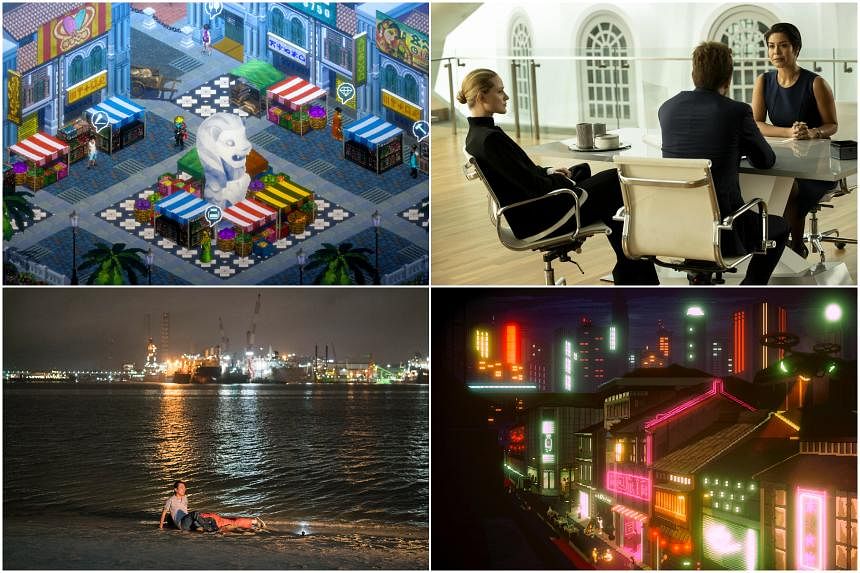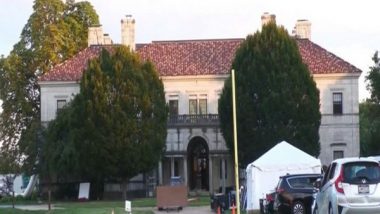From films to TV shows to video games, Singapore has seen a surge in its representation on global screens in recent years. SINGAPORE – Singapore has seen a surge in its representation on global screens in recent years. From the 2018 blockbuster movie Crazy Rich Asians to the TV series Westworld (2016 to 2022) to the video game franchise Battlefield, the island-nation punches above its weight when it comes to visibility in the global media.
However, these portrayals often come under scrutiny for being culturally off-base and lacking authentic characterisation – creating fictional Singapore without Singaporeans. Says Mr Tan Ker Wei, 28, a video editor and gaming enthusiast: “On the one hand, I’m happy that our tiny country is starting to get recognition globally, especially since it means fewer people will mistake us for being part of China. “On the other hand, I find that most of the representation on the big screen in works from other countries tends to be shallow or insignificant, and seen more as a novelty.

” As the Republic celebrates its 59th birthday, a growing number of works – many by local creators – are finding their way to international audiences and winning praise for the care that went into carving out authentic renditions. Experts and creators say the media can miss the real Singapore because its most recognisable element is its futuristic modernity. But what does an authentic Singapore look like in the realm of film, TV and video games? Singapore without Singaporeans? Perhaps the most well-known global example of Singapore on the big screen is Crazy Rich Asians, the romcom based on the novel of the same name by Singapore-born American Kevin Kwan.
Though the film drew praise in the US for its unprecedented level of Asian representation, it had a mixed reception in South-east Asia, including Singapore. Among the complaints was that it revolves almost entirely around East Asian characters, failing to acknowledge the racial diversity of the country that forms the film’s primary setting. Dr Jinna Tay, a senior lecturer at the National University of Singapore’s department of media and communications, says that with Crazy Rich Asians, “Singapore is essentially serving as a backdrop, but it is not a Singapore film”.
Considering the film’s representation “very flat”, she adds that it primarily foregrounds traditional Chinese culture instead of a uniquely Singaporean culture. “It could be found in Hong Kong, Singapore, Taiwan, a Malaysian-Chinese family. It could be anywhere, it just happened to be us,” she adds.
As the story focuses on members of the Chinese diaspora, it can be seen more as a diasporic narrative than a local one. The 2018 movie Crazy Rich Asians drew praise in the US for its Asian representation, but received a mixed reception in Singapore. PHOTO: WARNER BROTHERS Still, Crazy Rich Asians is part of a broader trend when it comes to depicting Singapore for global audiences.
The prevailing focus is on the country’s futuristic and modern aesthetic, luxurious trappings, colonial history and appeal as a dystopian setting. These range from period dramas, such as The Singapore Grip (2020), to sci-fi series such as Westworld to blockbuster video game franchises such as Call Of Duty and Battlefield. The video game Overwatch, a multiplayer shooter published by Activision Blizzard in 2016, prides itself on the diversity of its playable characters.
The franchise has spawned popular video game icons such as Brazilian DJ-activist Lucio and Chinese ice scientist Mei. In 2020, the game’s developers introduced a Singaporean robot named Echo as a playable character. In Overwatch’s fictional world, Echo is a robot created by a Singaporean scientist to be the peak of artificial intelligence.
The character, voiced by a British voice actress, has lines referencing its Singaporean origins, using Singlish phrases such as “alamak”, “shiok” and “can or not?” in a foreign tone. In Overwatch’s fictional world, Echo is a robot created by a Singaporean scientist to be the peak of artificial intelligence. PHOTO: ACTIVISION BLIZZARD This form of representation received a mixed reception, with some netizens calling it “cringeworthy”.
One Reddit user commented: “Singlish intonation without the rhythm, that’s what it is. Really strange.” “There is the issue of language,” says undergraduate Wali Khan, 23.
“Very few pieces of art get our language right.” The fan of international cinema adds that this is especially noticeable in Crazy Rich Asians. Still, he concedes that achieving authenticity would have been difficult because one would need to understand three to four dialects and languages to get it right.
“I think there needs to be more media set in Singapore because it has got such a rich and thrilling history. But the difficulty of creating stories that sound authentic and not with forced references makes the city’s soul hard to find,” he says. Visual shorthand for modernity Another high-profile instance of Singapore on screen can be seen in the third season of HBO’s blockbuster sci-fi series Westworld, which premiered in 2020.
It included sequences filmed and set in the Lion City, spanning places such as National Gallery Singapore, Lasalle College of the Arts, Marina One and Pulau Ubin. Among Westworld’s filming locations in Singapore was Marina One (pictured), Chinatown and The Oasia Hotel Downtown. PHOTO: WARNER BROS DISCOVERY However, most of these locations were repurposed on screen as a futuristic version of Los Angeles four decades into the future.
The few scenes depicting Singapore in Westworld’s fictional universe take place in Orchard Road and Chinatown, where one of the show’s protagonists has a run-in with the Japanese yakuza. In short, Singapore without Singapore. For showrunner Jonathan Nolan, the decision to film here came down to aesthetics.
The British-American told media outlet Variety: “I love America. Great place. But we haven’t spent the kind of money that you’ve seen spent (in Asia), in terms of infrastructure, public transportation and airports.
“The experience of going to any major Asian city is always a little bewildering and humbling on that level. It really does feel like you’ve gotten in a time machine and stepped forward 20, 30 years into the future. It’s the old William Gibson thing, right? The future is here.
It’s just unevenly distributed.” Gibson is the American-Canadian author widely credited with pioneering the cyberpunk genre. National Gallery Singapore was one of the filming locations for Westworld, but it was presented as a high-tech bank in a futuristic version of Los Angeles.
PHOTO: WARNER BROS DISCOVERY Westworld is not alone in making use of Singapore’s ultra-modern aesthetic. The Call Of Duty video games depict it as a futuristic city overrun by disaster, becoming an abandoned wilderness. Says Dr Tay: “If our country and urban spaces lend themselves as a canvas for these sorts of productions, then I think our urban engineers are probably quite happy with that.
” “There is a certain sort of visual recognition of the beauty that we put together,” she adds. “Maybe, the Singapore Tourism Board and Urban Redevelopment Authority will be quite delighted that we got our urban facades into these sorts of global texts in one way or another.” She notes that Singapore has certain “essentialising factors” that lend themselves to tropes about hyper-modernity and futurism, such as the city’s urban skyline and engineered environments.
Global narratives set here tend to use global spaces such as Chinatown or the Central Business District, because these are created for worldwide consumption. However, the spaces people think of as local – like Housing Board flats and coffee shops – are made for local consumption and practices. “If you think about the local versus the global, the gaze of these mega global texts is really that Singapore is made and beautified and engineered, but these are essentialised spaces for global consumption,” says Dr Tay.
And, with Singapore’s cost of living and civil liberties making headlines, she believes that it is easy for a creative to go, “let’s use this metropolis and further exaggerate elements of it” – making the country a visual shorthand for some creators when they want to feature ultra-modern or dystopian themes. Beyond the crazy rich Not all stories that are about Singapore or set here fixate on the lives of the wealthy, or Singapore’s ultra-modern elements. Ilo Ilo (2013), which delves into the lives of a middle-class family and their Filipino domestic helper, was the first Singaporean feature film to win an award – the prestigious Camera d’Or prize – at the Cannes Film Festival.
Another story exploring the lives of people in Singapore is A Land Imagined (2018), a neo-noir mystery film helmed by home-grown director Yeo Siew Hua. Much of A Land Imagined is set and filmed on Singapore’s reclaimed land. PHOTO: AKANGA FILM ASIA It begins with a simple premise: A cop investigates the disappearance of a Chinese migrant worker.
Through it, Yeo takes viewers on a surreal and dream-like journey into Singapore’s industrial land reclamation sites and the invisibilised migrant workers who labour in them. For Yeo, the work’s starting point was a desire to create a film shot mostly on reclaimed land. Singapore has increased its landmass by more than 20 per cent since it began its reclamation efforts.
“During the writing of the script, I visited all these spaces. It was also at the reclaimed west of Tuas that I got to meet the migrant workers who would become the main subject of my film,” he adds. The cast includes Liu Xiaoyi as Wang, a disillusioned migrant worker from China, and Ishtiaque Zico as Ajit, a migrant worker from Bangladesh.
When Wang disappears, Peter Yu’s detective Lok retraces his steps by diving into crammed worker dormitories and dusty construction sites. Yeo says part of the film’s purpose is to shine a light on the living conditions of low-wage migrant workers. “Given that one out of every five people you meet (here) is an immigrant, then any depiction of Singapore is not really complete without also including them in the picture,” he says.
“Many Singaporeans had never seen the inside of a migrant workers’ dormitory before this, and yet they are so integral to the story of Singapore and the building of it.” Film-maker Yeo Siew Hua says that part of the motivation behind creating A Land Imagined was to give viewers a rare glimpse into the lives of Singapore’s migrant workers. PHOTO: AKANGA FILM ASIA One of the film’s memorable exchanges is set on the coast by night, amid the burgeoning romance between cybercafe worker Mindy and migrant worker Wang.
The two are sharing their wistful dreams, when Mindy tells Wang that the land they are on was once part of the sea. “Singapore’s southern coast is completely straight, as if someone drew a line,” says Mindy, who is played by actress Luna Kwok. Wang responds by explaining that the sand is imported from Malaysia, Indonesia, Vietnam and other places, leading Mindy to quip: “Doesn’t that mean we’re no longer in Singapore? We’re actually lying in Malaysia.
” After this, the pair resolve to see the world by exploring Singapore’s reclaimed land. Yeo says: “The metaphor at the heart of the film, as alluded to by the title, refers to the make-up of Singapore as a country where both its land and labour are imported. It seems to defy natural borders and demography to constantly reshape itself and its population.
” In A Land Imagined, this artificiality and focus on the industrial grind of Singapore’s land reclamation sites are more than just a backdrop and aesthetic. This, and the island’s invisible builders, form the story’s central theme and characters. Another set of works which delve into lesser-seen perspectives of Singapore are period dramas.
Over the decades, these have spanned works on the lives of foreigners in Singapore’s colonial or post-war history – such as Serangoon Road (2013) or The Singapore Grip – and those presenting more local, nostalgic narratives, like Last Madame (2019) and The Awakening (1984). The Singapore Grip is among the works focusing on the lives of foreigners in Singapore’s colonial or post-war history. PHOTO: BBC FIRST Dr Tay says there are reasons why period dramas resonate strongly with creators and viewers alike.
Stories set in the distant past allow creators to take certain liberties, while also falling back on tropes, such as the damsel in distress. “I think historical dramas have two ways of dealing with this,” says Dr Tay. They can use familiar frames like the strapping and good-looking male protagonist, or feature characters who break with the norms of their time.
The film Bugis Street does the latter by delving into the lives of a group of Singaporeans in a bygone era. It premiered in 1995, but was banned here for 20 years before making its return to local screens in 2015 at the Singapore International Film Festival. Now showing at The Projector, the film tells the story of a young woman named Lien who, in search of a new life, journeys from Melaka to Singapore and enters a community of transvestites at Sin Sin Hotel in Bugis Street.
The film Bugis Street offers a rare glimpse into a seedier era in Singapore in the 1960s to 1980s. PHOTO: THE PROJECTOR Mr Melvyn Loey, 43, watched the film for the first time in 2024 and says: “I thought it was sentimental, nostalgic, exaggerated but beautiful. It is unapologetic about the seedier side of Singapore that existed in the 1980s, which I’m nevertheless proud of because it’s part of our heritage, culture and history.
” The legal consultant also thinks that the depiction of Singapore in the 1960s and 1970s was authentic in its gritty portrayal of life on the fringes of society, albeit with exaggerations and caricatures. “There’s a lot of landscape featured in the movie which no longer exists – and that contributes to the beauty of the movie and our history,” says Mr Loey. Matthew Foo, 55, one of the film’s actors, says watching Bugis Street at a recent screening was “surreal”.
The audience’s cheering at the end “brought tears to my eyes”. He played Dr Toh, a supporting character who leads a double life: doctor by day and larger-than-life queen of Bugis Street by night. Foo believes the film’s enduring power lies in its universal narrative.
At Sin Sin Hotel, the protagonist Lien discovers a new world where people have found a place where they belong and, in doing so, find themselves. Foo recalls Hong Kong director Yonfan’s meticulous attention to detail in capturing the pre-1990s era, going to great lengths to ensure every frame was period-accurate and sourcing everything from specific buses to authentic make-up and costumes. “In Bugis Street, there are so many lost details from that era.
Audiences now are quite taken by the fact that they are able to see it at this present moment in its authenticity,” says Foo. Pursuing authenticity World-building is an art form for creatives, and Singapore is a land ripe with potential inspiration. However, the form and manner that this inspiration takes vary widely, and can sometimes rely on a messy pot of orientalist tropes.
Within the Marvel comics and Marvel Cinematic Universe (MCU), the island-state of Madripoor is said to be modelled after Singapore, Indonesia and Hong Kong. Within the Marvel comics and Marvel Cinematic Universe, the island-state of Madripoor is said to be modelled after Singapore, Indonesia and Hong Kong. PHOTO: MARVEL STUDIOS Created in 1985 by comic book writer Chris Claremont – best known for writing the X-Men comics – Madripoor is an island defined by deep inequality between its wealthy Hightown and its impoverished Lowtown, and is a lawless haven for pirates and criminals.
Within the comics, it serves as the stomping ground for Marvel characters such as Wolverine and Black Widow. Madripoor’s recent appearances in the MCU have been labelled by one critic, Mr Thom Truelove, as orientalist and “serving a ‘chop suey’ of tropes about South-east Asia” because of its references to poor odours and shoddy manufacturing, as well as appeals to mysterious exoticism. In Pirates Of The Caribbean: At World’s End (2007), an 18th-century version of Singapore forms an important set piece in the first act, where the protagonists meet a cast of pirate characters who are largely Chinese and led by Hong Kong actor Chow Yun Fat’s pirate lord Sao Feng.
Hong Kong actor Chow Yun Fat stars in Pirates Of The Caribbean: At World’s End as a pirate lord, and is introduced in an 18th-century version of Singapore. PHOTO: WALT DISNEY PICTURES In the film’s production notes, production designer Rick Heinrichs says: “In those years, Singapore was not a particularly well-documented place until the 19th century, so we looked at a number of other Chinese cities for reference. We took a deliberately fantastical approach, creating something like a Chinese/Malaysian expressionist style of what we think Singapore might have looked like at the time.
” In contrast, attention to cultural authenticity is one of the key selling points of the video game Ghostlore (2022), developed by Singaporeans Andrew Teo and Adam Teo. The action role-playing game is modelled after Activision-Blizzard’s Diablo video game franchise, in which players take on the role of heroes fighting monsters across a series of levels. In video game Ghostlore, which features enemies inspired by South-east Asian culture and folklore, the iconic Rafflesia flower is an adversary that protagonists must overcome.
PHOTO: GHOSTLORE Where Diablo features Western-style and Gothic demons as adversaries, Ghostlore features creatures such as the jiang shi, pontianak, aswang and manananggal – inspired by South-east Asian myth and folklore. According to Mr Andrew Teo, the decision to include the pontianak as an adversary at an early stage in the game development process started the conversation about how they could draw on the world around them to make Ghostlore a unique experience. “We started talking about the various monsters found in local horror stories and how unique they are, and I realised there were very few media that portray Singaporean culture, less so one made by a local Singaporean,” he says.
Thereafter, Ghostlore would draw heavily upon such folklore. Singaporean and South-east Asian culture also influence the game’s settings – a Singapore-inspired Seaport serves as the main hub of the game, alongside levels such as Pulau Hijawan and Hantu Tinggi’s Domain – as well as in-game weaponry, food and storylines. The video game Chinatown Detective Agency (2022) also draws inspiration from Singapore, specifically its futuristic cityscape and present-day culture.
Creator Mark Fillon says he based the world of Chinatown Detective Agency on his experience of living in Singapore. PHOTO: GENERAL INTERACTIVE CO Any Singaporean playing the game will notice many familiar sights and motifs, such as the distinctive urban design of local neighbourhoods, which are made over in a grimy sci-fi aesthetic. Just starting up the game presents players with a cinematic introduction that takes them through a lovingly crafted and pixelated re-creation of North Bridge Road between Clarke Quay and the Civic District, in glimmering and cyberpunk style.
The game is a point-and-click adventure, with players taking on the role of private detective Amira Darma to solve a string of cases from mysterious clients. Players are expected and encouraged to Google and rely on their knowledge of real-world trivia to solve cases. Knowledge of where one might find “a tree where a man became one with the universe” – a Bodhi Tree – in Singapore is an important clue in the game’s first case.
A striking element of the game is that every Singaporean character of the cast – from the playable protagonist Amira Darma to the game’s cast of librarians, cops and conspiracists – speaks with a distinctively Singaporean accent. “We made the decision early on that if the character is Singaporean, the voice actor has to be Singaporean,” says the game’s creative director, Mr Mark Fillon, 37, a Filipino. He says the game was inspired by his experience of living in Singapore, having moved here from the Middle East in 2015.
“Chinatown Detective Agency feels like a love letter to this city I love so much,” he adds. “There’s so much rich history behind it, so many side streets and nooks and crannies to get lost in. My mind kind of created this world of conspiracies, secret societies and detectives trying to get to the bottom of things in this futuristic setting.
” He developed the game with Brazilian designer Ricardo Juchem, 45. While Mr Fillon’s inspiration was experienced first-hand, Mr Juchem found himself exploring Singapore from his home country of Brazil. He set foot on the island for the first time only six months into the development process.
He created the game’s sprawling visual sequences and settings using photographic references taken by Mr Fillon and by exploring the city through Google Maps. Faithfulness to the real-world inspiration was a key principle for the designer. Video game Chinatown Detective Agency turns familiar sights across Singapore’s neighbourhoods – from Tanjong Pagar to Bedok – into its futuristic cyberpunk setting.
PHOTO: GENERAL INTERACTIVE CO In some cases, the inspiration for the game’s cyberpunk elements was very direct. It features robotic dogs patrolling Singapore’s streets. “That was a reaction to a news article we read in The Straits Times, where we saw a robot dog patrolling the park and monitoring people,” says Mr Fillon.
In other instances, Singapore was the slate on which to express dystopian and cyberpunk ideas which are global in nature rather than specific to Singapore, like a fictional conspiracy to privatise the water supply into a multi-tiered subscription service. “Chinatown Detective Agency allowed Ricardo and I to take this clean image of Singapore and kind of artistically destroy it and turn it on its head, because our world-building involved a Singapore that is going through a tumultuous and chaotic period in the world,” says Mr Fillon. This involved making over symbols of Singapore’s order, cleanliness and modernity, such as the MRT system.
Though the pair are proud of the level of care that went into developing a fictional world that stays true to its real-world inspiration, Dr Tay notes that what authenticity means is different for everyone. “The notion of authenticity is very much a construction,” she says. “When we think about authenticity and what it means to be authentic, it’s someone applying his or her idea of what he or she thinks is authentic.
” This is because everyone’s ideas and history are different. For example, a question about what one’s grandparents did during the war is likely to provoke a diverse set of emotional responses. Dr Tay also points out that when questions of preservation first arose during Singapore’s rapid urban redevelopment, the focus was on preserving historical legacy rather than cultural authenticity.
“The pieces that were then preserved are the slices of what people today recognise as authentic,” she adds. “But there might have been five or six different versions of shophouses or kampung that have already been destroyed and never recorded. Those other slices of authenticity will never have their day in the sun.
” In the end, she concedes: “When we talk about authenticity, it’s quite a difficult concept to capture.” Join ST's Telegram channel and get the latest breaking news delivered to you. Read 3 articles and stand to win rewards Spin the wheel now.



















